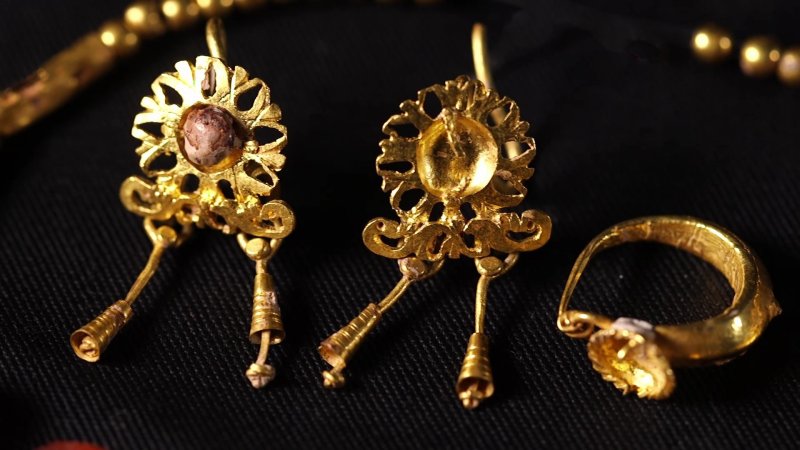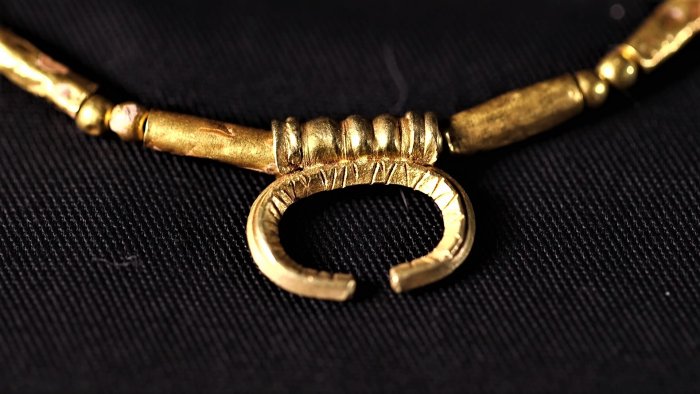In 1971, on Mount Scopus in Israel, an extraordinary discovery was made: an 1,800-year-old lead coffin containing a young Roman girl adorned with precious jewelry to ward off the ‘evil eye’ and protecting her in her passage to the afterlife. These forgotten treasures have been rediscovered in storage at the Israel Antiquities Authority and will now be exhibited for the first time.
The protective jewelry will be exhibited at a conference of the Israel Antiquities Authority, the Israel Exploration Society, and the Israel Archaeological Association. The newly found treasures include gold earrings, a hairpin, beads made of gold, carnelian stone and glass. Among them is a gold pendant, known as a lunula, that is shaped like the crescent moon and named after the Roman moon goddess Luna, according to a IAA press release.

The discovery of these jewels contributes significantly to our understanding of the material culture and social practices of the late Roman period in Jerusalem. The discovery of these exquisite pieces amongst the grave goods found at the burial site indicates that the Roman girl was of high status. This ancient jewelry provides a window into the aesthetics of the time, along with the religious practices and beliefs, explained the IAA.
The Mysterious Origins of the Forgotten Jewelry
The origin story of these gold jewels rediscovered in Israel remains shrouded in mystery, with the owner of these exquisitely fashioned pieces remaining yet unknown. They were originally discovered amid the debris of a lead coffin in a burial cave in Jerusalem that had been destroyed by a bulldozer in 1971, explained Dr. Ayelet Dayan of the IAA, who led the project.
Yael Adler of the Israel Department of Antiquities investigated the ancient burial at the time, but she passed away before the finds could be published. The artifacts went into storage at the IAA and were forgotten, until now.

“The location of the original reports that gathered dust over the years in the Israel Antiquities Authority archives, and physically tracing the whereabouts of the items themselves, has shed light on long-forgotten treasures,” said Dr. Dayan. “The beautiful jewelry that we researched is an example of such treasures.”
In the IAA’s defense, Dayan points out that there have been a lot of excavations since Israel’s establishment. In fact, archaeological investigation of the Holy Land goes back over 150 years, but since 1948 alone there have been perhaps over 9,000 excavations. Excavating for forgotten treasures in the IAA cellars, the team has been mapping the finds and came across this collection from the destroyed burial cave.

Understanding the Forgotten Jewelry
The most intriguing of the finds is the pendant shaped like a lunula amulet, which would have been expected to invoke the moon goddess Luna’s powers to protect the bearer from evil in the afterlife. The lunula shape was typically worn by girls or young women, while boys would be adorned with an equivalent called a bulla.
Finding the pendant in the debris from the grave in an IAA drawer, and the circumstances of their discovery back in 1971, indicates that the burial was of a girl in the late Roman period, Dayan says. The moon as deity actually goes back to the earliest days of civilization as we know it. Evidence of the moon cult exists not only in finds, such as the moon god stele of Geshur, but in place names like Jericho and Beit Yerah – from Yarekh, meaning moon, according to a Haaretz report.
The jewelry was characterized based on finds around the ancient Hellenistic and Roman worlds, not in Israel but in ancient Egypt and European cemeteries. Similar artifacts were typical of burials from the second to fifth centuries (the late Roman and early Byzantine periods), Dayan explained. Statistically, the lunula shape is most common in graves of young women.

Following the Roman victory over the Jewish rebels of Palestine once and for all, Jerusalem was rebuilt as Aelia Capitolina and its population was Romanized, Dayan pointed out. People from all over the empire settled in the city.
“The interring of the jewelry together with the young girl is touching,” said Eli Escusido, director of the Israel Antiquities Authority. “One can imagine that their parents or relatives parted from the girl, either adorned with the jewelry, or possibly lying by her side, and thinking of the protection that the jewelry provided in the world to come.”
When discussing the stunning 1,800-year-old forgotten jewelry and evil eye found on Mount Scopus in Jerusalem, and then rediscovered in IAA storage, Escusido concluded: “This is a very human situation, and all can identify with the need to protect one’s offspring, whatever the culture or the period.”





